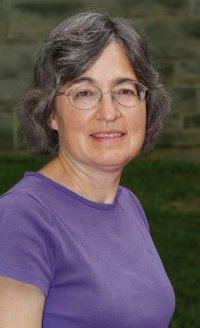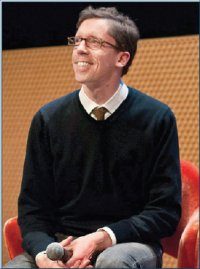Joan Slonczewski: Field of Discovery

Joan Slonczewski was born August 14, 1956 and raised in Westchester County NY, daughter of a theoretical physicist and a violin teacher. She decided to become a scientist at an early age, and attended Bryn Mawr, graduating with a biology degree in 1977. She finished her PhD in molecular biophysics and biochemistry at Yale in 1982, and did postdoctoral work at the University of Pennsylvania. In 1984 she began teaching at Kenyon College, where she has remained as a professor of microbiology (and occasionally science fiction), with sabbatical leaves at Princeton and the University of Maryland. While at Yale, she became a Quaker and worked in the peace movement.
First novel Still Forms on Foxfield appeared in 1980, and her other standalone, The Wall Around Eden, in 1989. Campbell Memorial Award winner A Door Into Ocean (1986) began the Elysium series, which includes Daughter of Elysium (1993), The Children Star (1998), and Brain Plague (2000). She began the Frontera series with The Highest Frontier (2011), also a winner of the Campbell Award.
Excerpts from the interview:
‘‘My college experience at Bryn Mawr and Haverford impressed me with the power of Quakerism. While at Yale grad school, I joined the Society of Friends and became fascinated with it as an alternative form of politics. I was part of the group that organized the nuclear freeze movement. Within a couple of years we held a demonstration in New York City that drew two million people. The history books say that our movement forced Reagan to start seriously making peace with Russia.
‘‘Still Forms on Foxfields was my first book, and I started writing that in college. I had read Ursula Le Guin and thought, ‘I could write like that.’ I felt anxiety about nuclear war; at the time I didn’t see how we were going to get past that. So I wrote SF out of that impulse to create worlds that would exist after nuclear war. Positive worlds. Through the Society of Friends, I discovered that human beings already have the means to avoid war and solve planetary changes. I saw the Friends’ philosophy as a guide to do that. I wrote A Door Into Ocean on that basis, arguing that this is the way to do it, and we can not only get beyond war, but we can also solve climate change and so on, and this is the human blueprint for how to do that.
‘‘A Door Into Ocean was rejected by Del Rey, which had published Still Forms. It was rejected by several other publishers. This was before the collapse of the Soviet Union, and there was an absolute dogma that peace never works. Nobody wanted to look at a book that said otherwise. A classmate of mine from Bryn Mawr was an assistant at David Hartwell’s office. She passed the book on to him, and he wanted to publish it. Two years after A Door Into Ocean was published, all the revolutions collapsed. Communism collapsed in Europe. Before A Door Into Ocean there was absolutely nobody writing about peaceful revolution. In fact, people told me that it was unpatriotic. Peace revolutions take 20 years, they don’t happen overnight. That’s true of the Arab Spring, too. It didn’t just happen. There was a long preparation.”
…
‘‘Gender issues have always impacted my career. When my first book came out in 1980, the only readers I heard from were Quakers – and gay people, because I included one positive gay character. So from then on, I addressed alternative sexualities throughout my books. The ocean women of A Door into Ocean are pansexual – they love regardless of gender. One time in class, my students were discussing my book Brain Plague. I asked the class, ‘Is this book liberal or conservative?’ A student said, ‘It’s conservative, because all the characters are married.’ Another student jumped up, ‘It is not conservative!’ Half the book’s marriages are gay – with a few robots included.
‘‘In my career, many hard-science authors like Greg Benford and David Brin have been very supportive. Other male authors, however, have disparaged my work. When women write hard SF, there is often pushback from certain male writers. ‘What are you doing? This isn’t really hard science.’ I’ve seen that on the Internet and it’s something I fight back against. Anybody that says anything mean-spirited about my work, I fight back. I want to stress that it’s a minority, but it’s a vocal minority. Women writing hard SF get pushed back. But I have also really appreciated support from the community, and I’ve been invited to contribute to Charles Stross’s blog. I now run my own blog, at Ultraphyte.com.”
…
‘‘I also write the leading microbiology text book for undergraduate science majors, Microbiology: An Evolving Science, co-authored with John W. Foster. My textbook features the prominent laboratory evolutionist Richard Lenski – and was singled out for attack by creationist Ken Ham in his ‘debate’ with Bill Nye. The creation controversy as a social phenomenon fascinates me, and led to a major plot theme in The Highest Frontier.”
…
‘‘The politics of science is our politics, because our greatest challenges today are how to keep the planet alive and how to keep ourselves alive. What are people concerned with? Everybody wants to live forever, let’s face it. To live healthily forever. At the same time everyone wants to have a planet healthy enough to live in, and those are fundamental challenges that face all human beings, and increasingly those are challenges of science.
‘‘So how do we respond to science? One response is to embrace the new discoveries, whatever they are, no matter how shocking. To some extent people are willing to do that. For instance, if you can save the life of your child by producing new embryos in a dish and picking the one whose genes can save your child, you will do that. People do that now, with surprisingly little controversy. If you need to eat shit in order to save your digestive track – a digestive bacterial transplant, or fecal transplant – people will do that.
‘‘But on the other hand, if you need to accept that the world is 4.5 billion years old, that’s too shocking for some people. I live in a community where we had a middle-school teacher that was fired after teaching creationism for 11 years. The community I live in, the community surrounding the college, includes some people with this cultish view of rejecting science, rejecting climate change. I face that every day. In a way, it’s a good thing because I have to deal with that. Whereas people who live in a city, they can say ‘That’s fringe,’ but it’s not fringe, because to be a presidential candidate in one of our two major parties you have to deny evolution. What’s up with this?
‘‘The trouble is that some people think false science has no consequence. Who cares if it happened six thousand years ago or four billion? But it does have a consequence, because we are evolving creatures. Biology is evolution. If you want medicine, that’s evolution. The planet is evolving, life forms all over the planet are evolving to cope with climate change. Forests, as part of their response to increasing carbon dioxide, now draw less water from the earth. The problem with that is that if they draw less water from the earth, then they make fewer clouds. Trees make rain – you think rain makes trees, but trees make the clouds. We’re going to have fewer clouds that make rain then. It will become drier because of the CO2 effect.
‘‘People who reject good science don’t realize they are manipulated by powers that earn money off their disbelief. The people who have churches that believe this stuff sincerely don’t realize they are manipulated by the Koch brothers and by other entities that stand to make a lot of money off technologies that are destroying the Earth, like fracking. You have this coupling of the industry that wants to frack and so on with the science-denying churches, and the churches don’t realize how they are being manipulated.
‘‘In The Highest Frontier I try to show both creative and destructive expressions of faith. The college chaplain is the force for progressive religion, religion that humanely engages science. Whereas there is another view in the book, the geocentrist view that says everything just centers around the Earth. People think that is ludicrous, but in fact, geocentrism is out there. The fascinating thing is that science deniers are appropriating more – they are starting to deny physics as well as biology. They deny cosmology, and the creation museums present this anti-cosmology view. There was even a conference in Chicago of geocentrists. In one way or another, science deniers like Ken Ham are arguing that the entire universe centers on the Earth. It’s up to the rest of us to tell the much more inspiring story of biology and science fiction.’’





